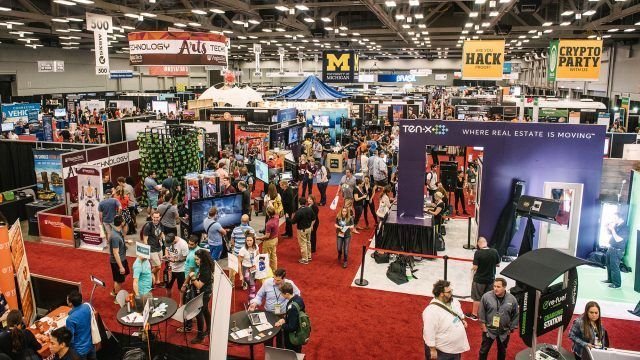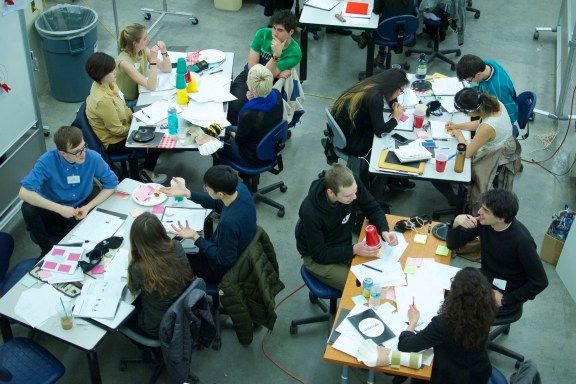
The usual scene at South by SouthWest
Austin’s South by Southwest festival is known for its extravagant product launches, late-night boozing, and opportunities for famous techies to mingle with guests. Successful apps and products like Twitter, Foursquare, and Meerkat have all started at the podium of the festival. But in between the celebrities and press conferences, a much larger and less bombastic trend revealed itself at John Maeda’s 2017 Design in Tech Report.
Maeda, the revered designer and tech innovator, spoke on the start of a change towards “InBetweeners” within the industry. His report expanded on these hybrid designer-developers, InBetweeners, as artists equipped with “hard” science skills such as engineering. This new blend is something the tech industry has never experienced before.
According to the National Education Association 40% of designers reported being involved in the engineering and development process. Additionally, 1 of 4 design leads have trained for an engineering degree. It’s happened quietly but Maeda sees the line between the two folding. And Maeda is not alone in this thinking. Outside of the festival and tech-soaked scene of Silicon Valley, a movement known as STEAM, STEM + arts, sees an opportunity to change the image of the typical engineer and STEM itself.
___________

Two thousand miles away from Austin at the Rhode Island School of Design, Minsoo Thigpen mulls over plans for STEAM in the upcoming year. What started as an off the cuff remark in 2008 during a RISD board meeting by Jon Kamen, Chairman and CEO of RadicalMedia, has turned into a movement with schools, employers and even has congress involved. As the president of the STEAM student club at RISD, Minsoo is the poster-child of the movement. Studying both painting and applied mathematics, she doesn’t fit into any particular category.
Minsoo hails from Huntsville, Alabama and travelled from the Deep South to the Ivy League enclave to combine her disparate interests of art and science through a dual degree at RISD and Brown University. As a freshman, she was wholly uncertain of how the two fields would mesh; she only knew that she didn’t want to give up either.
Talking with Minsoo on the phone four years into the program, she describes at length the historical intertwining of art and science from the fifth century all the way through the secularization of 19th century Germanic universities. But today she is obsessed with the release of the latest STEAM course catalog, which showcases everything from a music cognition workshop at Brown to a virtual reality hackathon sponsored by Google.
With the integrity of an artist and bluntness of an engineer, she exclaims, “I couldn’t be a Sunday painter.” Minsoo was certain that entering the dual-degree program would ensure that her future would be larger than painting on the weekends. When I asked about the prospect of a job, she seemed unfazed. She held a vague idea of working in data science as a product designer where she could work with new ideas and oversee how algorithms would be implemented.
For many students, the lack of a job offer would be overwhelming. But with STEAM and RISD, the opportunities are potentially boundless. Currently, RISD and STEAM attract many of the largest tech companies like Intel and Boeing who reach out frequently for the opportunity to recruit graduates. Lockheed Martin now routinely attends RISD’s career fair. Perhaps even more valuable than a clear career plan is the privilege of time that STEAM can afford.
Outside RISD and the world of STEAM at the University of Miami in Cincinnati, student Nicolae Sadovnic is trying to put into words exactly what he’s doing in college. Twenty-year-old Sadovnic is an art major, but he’s also a programmer with an interest in music. Sadovnic is not just a curious mind or another confused student—he’s an InBetweener.
Sadovnic started college by pursuing a degree in accounting, but during a particularly punishing late-night study session in 2015, he realized he had no desire for the profession. He stopped cramming and switched to a more artistic major. After switching, he immediately felt pressure from teachers, advisors, and even other students, all of whom were judgmental about his lack of career certainty.
“There’s also this pressure to have a ten-year plan,” he says over the phone. “You need to know exactly how your life will shape up.”
The school’s nationally ranked business program gives many of its students access to careers with straightforward paths towards advancement. As a hybrid artist-engineer, Sadovnic did not have the same clarity.

But two years after his initial switch from accounting, Sadovnic recently hosted his first art show. Titled “Feedback,” the exhibit explored the loss of self as technology becomes more invasive. Sadovnic commented, “I'm fascinated by the way technology is…dissociating us.” Sadovnic programmed synthesizers and paired the sound with a projected 3D image.
The programmed synthesized piano organically degraded into simpler sounds as the 3D image devolved. The piece showcased Sadovnic’s early ambitions of fusing engineering and art to create a grander experience. Subsequently, it also sharpened his career outlook. He has an interest in interactive advertising, an idea honed over years. But when I asked him about STEAM, a movement geared toward creatives like him, he says he has never heard of it.
The only support Sadovnic found at his university was one major called Interactive Media, a degree that had less than 2 percent of the student body enrolled in it. The school did not offer any of the classes he needed, so he was forced to create a patchwork education through independent studies and professors.
Much of the early work in STEAM at the Rhode Island School of Design (RISD) was centered around this very problem. Gifted students were scattered around the country without any real support network. STEAM’s Sarah Pease recounts that they were inundated with requests for advice. Third grade teachers called for a curriculum for their classrooms and California college kids called looking for help with their projects. She said, “We were about to kill our own movement, we generated so much interest we couldn’t handle the inbound communications we were getting.”

Staff set out to develop the STEAM map as a way of connecting people across the country who shared in an interest in the movement. The interactive map wasn’t just a resource—it signaled to hybrids that there were other practitioners, teachers, and even employers eager to help.
Their efforts seemed to reach a tipping point in the fall of 2012. A small STEAM-sponsored talk by the rapper GZA of the Wu Tang Clan snowballed into the largest event in school history. GZA, known for rapping about science and philosophy, sauntered into the sold-out auditorium to kick off his talk on physics and dark matter. At the time, the idea of a musician discussing the combination of art and science was bizarre at best. But the sold-out event put STEAM on the radar. Later that night, the chairman of RISD’s board called Pease to tell her they needed to talk. “How did you do that?” he asked her. “I’ve never seen so many people come for anything.”
And the excitement wasn’t confined to students at RISD; the talk brought in students from Brown University and other Ivy League schools. Educators set up a “superhighway” where engineers from Brown could take art classes at RISD and art students from RISD could take computer science classes at Brown. The smattering of ideas resembled the Italian Renaissance universitas magistrorum model, where students’ intellectual desires rather than highly specialized job training were at the forefront.
Across campus, students raced in homemade moon buggies as part of a challenge sponsored by NASA. The event drew a diverse crowd, and many of the participants were female designers, who previously may have been hesitant to become involved in such STEM-oriented efforts. The moon buggie project would be one of the highlights of the first STEAM annual catalog—the same catalog Minsoo would design years later.

Brown University and RISD students at work on C+STEAM, a project that explores how computer, science, and technology can create art.
Today, STEAM is a nationwide effort. Programs involving high schools, universities, and corporate supporters like Intel and Boeing exist across the country. These programs are in place so that students like Nicolae Sadovnic, who are strangers to the Ivy League system, are not overlooked.
For people like Jon Kamen, the board member who coined the term, he’s seeing a shift towards entire companies becoming STEAM. His company RadicalMedia works in the documentary and production space and employs a mixture of technically skilled artists. The company has produced the likes of Fog of War, Netflix’s What Happened, Miss Simone?, and other films; and now he even refers to RadicalMedia as a “STEAM company”.
According to Kamen, Airbnb paved the way for STEAM type companies and its creating a new conversation. It’s clear STEAM won’t be replacing STEM anytime soon but a shared platform seems to be burgeoning: one where art is intertwined with the sciences in a way previously unheard of.
Please share and recommend if you enjoyed this piece. This is part of an in-depth series about mastery brought to you by Habits and Design. Habits and Design is about the intersection of culture and data. For more engaging stories, sign up and receive exclusive content.
